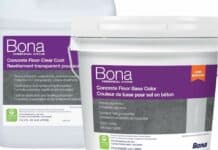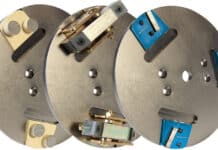 By Ron Bridges
By Ron Bridges
In addition to being visually appealing, concrete floors have gained in popularity due to their relative ease of care. They require less labor and expense to maintain, especially in comparison to vinyl or tile.
There are also environmental advantages to concrete, including a reduction in airborne contaminants, better indoor air quality (IAQ), lower opportunity for mold growth, and the ability to be cleaned with nontoxic chemicals or those with a lower amount of volatile organic compounds (VOC). It is also considered a greener option than carpet and other surfaces that will have to be disposed of after they exceed their lifespan.
Knowing how to properly prepare new or old concrete floors is imperative to gain the desired finish and protect those completing the job. It’s also important to consider floor care once the job is done. Following some best practices can help.
Focus On Safety
Before beginning any prep work, it is critical to understand and implement the proper safety precautions. Standard personal protection equipment (PPE) applies. Workers need to wear steel-toe boots, safety glasses, and work gloves.
When working in small, confined areas be sure to wear hearing protection; the propane motors used to power some equipment can be quite loud. Also be sure that there is proper ventilation when using propane. There are tags that workers can wear that alert them if they are starting to be exposed to too much carbon monoxide.
Most importantly, always protect against silica dust that becomes airborne when grinding and shot-blasting concrete. Silica dust is very dangerous because it can cause scar tissue to develop in the lungs. The Occupational Safety and Health Administration (OSHA) sets the legal limit or Permissible Exposure Limit (PEL) for silica in the air at 50 µg/m3. If dust containing silica is visible in the air, it is over the permissible limit. The safest amount of silica in the air is zero, but since that isn’t realistic, workers should wear a KN95 dust mask for breathing protection.
Additional protection against silica includes using water on the concrete when grinding, adding air scrubbers to the space, and/or implementing properly sized HEPA dust collectors. When using dust collectors, be sure to clean them regularly to prevent silica dust from reentering the space.
Evaluate The Concrete Project
The best way to approach a concrete surface prep project is to know the existing condition of the floor and what the goal is for the finish. This helps ensure that the correct equipment is in place and that the goal is achievable. The starting point may be a thick or thin coating, vinyl composite tile (VCT), sealer, ceramic tile, carpet, or existing concrete. The goal may be polished concrete, concrete overlays, or a surface with thick or thin coating. In some cases, the goal may be to seal the surface.
It is also important to consider the age of the concrete. As a general rule, it is best to wait until it is 28 days old before grinding, as the material under the surface is still solidifying when it is newer than that.
Next, calculate the square footage of the space and find out whether there are any time constraints to the job. This will help establish the type and quantity of machines needed to gain the desired results within the allotted schedule.
Determine what power is available and its location, as well as how to access the space. Are there stairs or an elevator?
Finally, be realistic when evaluating the project. If the concrete has flaws that need to be patched, it might not be possible to get a clean, polished finish. The stain will show the blemishes. If that is not the desired surface characteristic, it may be better to finish the concrete with a thicker coating.

Select The Right Equipment
The project evaluation provides the basis for choosing the right equipment. There are several options based on the starting condition and desired end result, and two key factors to remember. First, avoid using equipment that is too aggressive for the end result since it can damage the concrete. Second, always prep the floor properly for the coatings being applied—some concrete needs light grinding, while others require a very coarse finish.
Mechanical scrapers are good for removing carpet, tile, overlays, hardwood, and more. They are available for rent in walk-behind or ride-on models and can be fitted with special blades for cutting the carpet into strips so it’s easier to roll up and throw away. Coarse diamonds can be used for grinding off adhesive left after carpet or tile has been scraped up. If there is still adhesive left after that, mechanized grinders can remove it. For aggressive removal, a 30- to 50-grit metal bond works well, while a 70-grit metal bond can start to smooth out the finish. When trying to remove a thick coating, polycrystalline diamond (PCD) scrapers are another option, but they must be used with caution because they can leave deep scratches in the concrete.
Shot blasters are useful for prepping the concrete prior to putting down coatings.
If the desired finish is smooth and matte, hone the concrete with a combination of hybrid and resin abrasives that are progressively finer.
For a polished finish, polishing pads operated on a floor grinder will provide varying levels of shine. Pads with 400 grit leave a flattened finish, while an 800-grit pad is the first step in which the concrete will begin reflecting light. Pads between 1,600 and 3,000 grit offer more clarity to the polish. Early in the polishing process, apply a densifier to advance preparation: It is absorbed into the concrete to harden it.
Conduct Regular Maintenance
Keep concrete floors in top shape with regular cleaning, which includes vacuuming or sweeping to collect dust and debris as well as mopping with a pH-neutral cleaner and clean water. A mechanized cleaner is another option that can speed cleaning over larger areas and should be done with light head pressure.
Be sure to clean up any spills as soon as they happen to prevent staining. Acidic stains require both cleaning and neutralizing to prevent etching of the concrete.
If the concrete is polished, daily sweeping and mopping prevents dirt and grit from scratching or wearing the surface. Using diamond-impregnated pads in conjunction with an auto scrubber helps refresh and revive the surface and restore it to its original shine. Use an 1,800-grit pad over several passes. One to three times a week, consider a high-speed burnish with an 1,800 pad to bring out the shine. Protective treatments can also be applied during routine maintenance to maintain gloss levels.
Protect The Investment
In addition to safe and proper concrete preparation and daily care, ongoing evaluation can provide insight into when to refresh and revitalize the surface. This is especially true for polished concrete. Along with providing equipment and training for the preparation, a rental partner can assist in restoration to keep the concrete surface in good shape and make it last.
 Bridges is currently a leader with Sunbelt Rentals as Sales Development Manager—Flooring Solutions and brings more than 35 years of experience in working with concrete. Such areas of experience include surface preparation, polishing, repair, and general maintenance. Bridges has been a longtime member of such associations as the American Society of Concrete Contractors, the International Concrete Repair Institute, Certified Flooring Installers, the Flooring Contractors Association, and the ISSA.
Bridges is currently a leader with Sunbelt Rentals as Sales Development Manager—Flooring Solutions and brings more than 35 years of experience in working with concrete. Such areas of experience include surface preparation, polishing, repair, and general maintenance. Bridges has been a longtime member of such associations as the American Society of Concrete Contractors, the International Concrete Repair Institute, Certified Flooring Installers, the Flooring Contractors Association, and the ISSA.




















![[VIDEO] Collect Asset Data at the Speed of Walking a Building](https://facilityexecutive.com/wp-content/uploads/2024/02/maxresdefault-324x160.jpg)